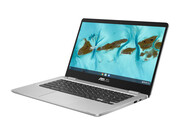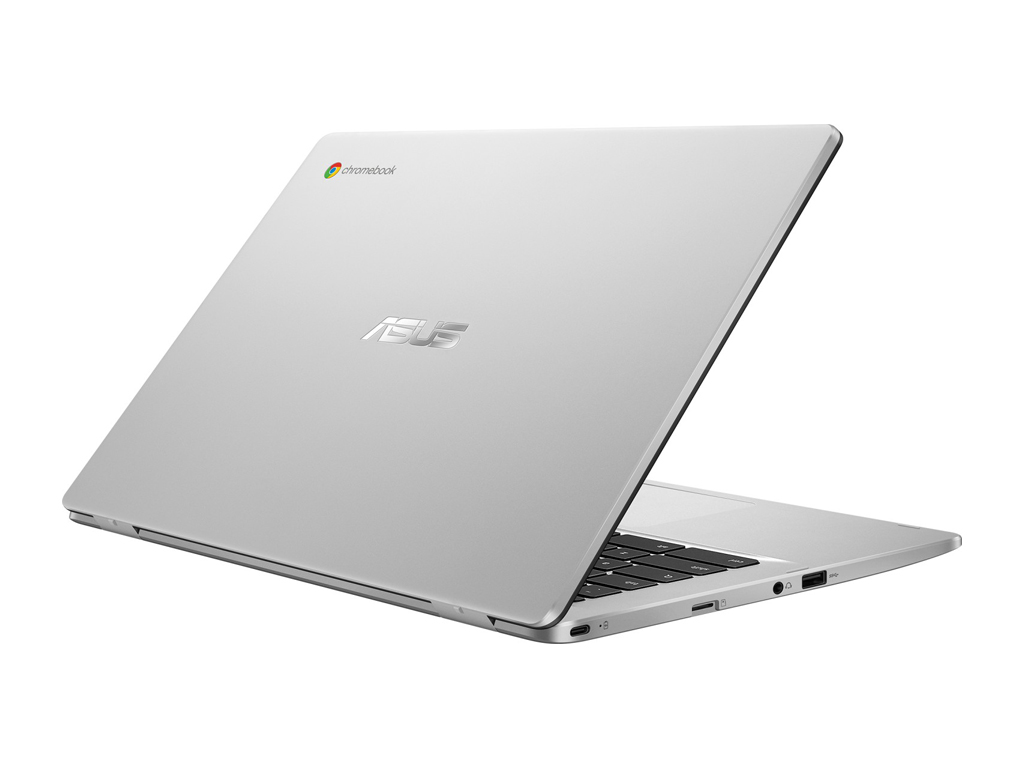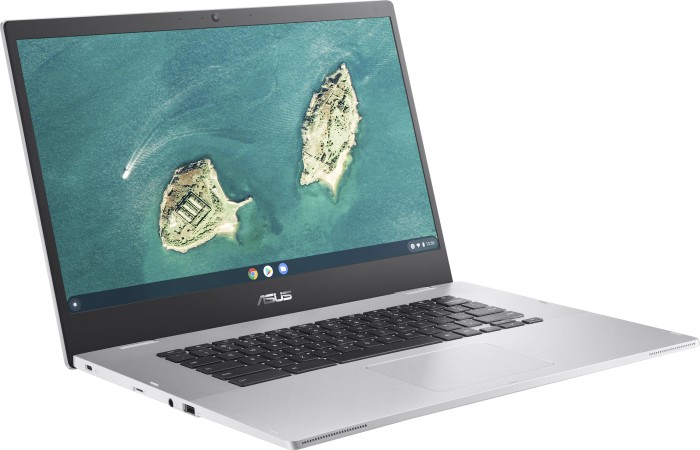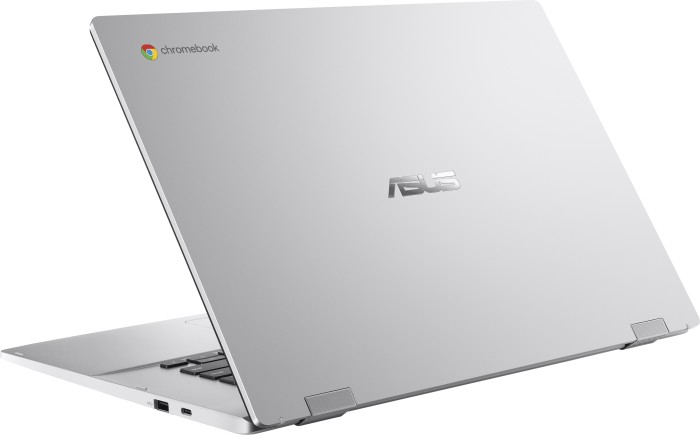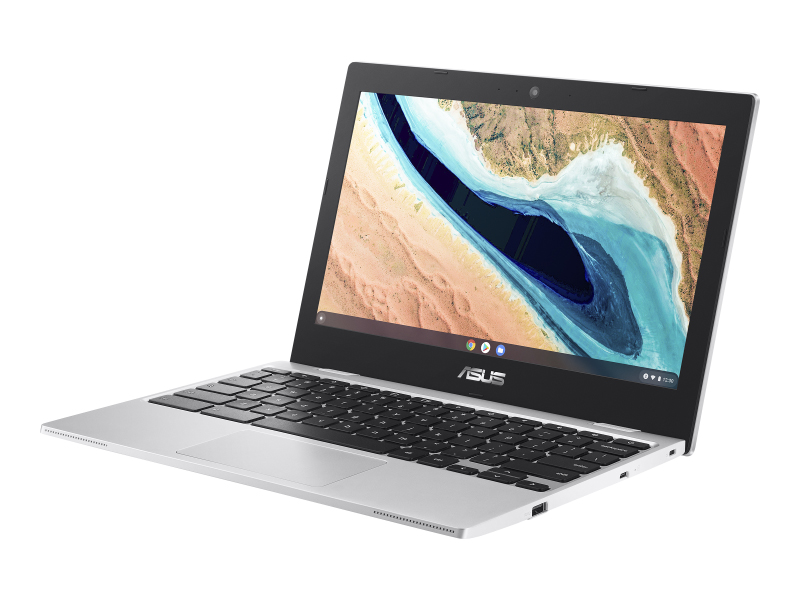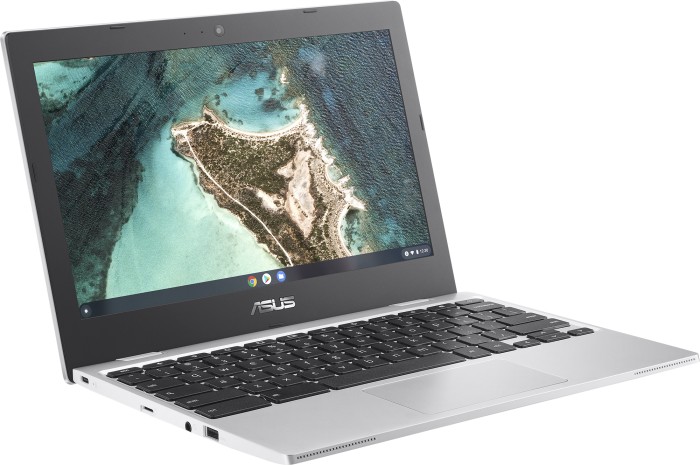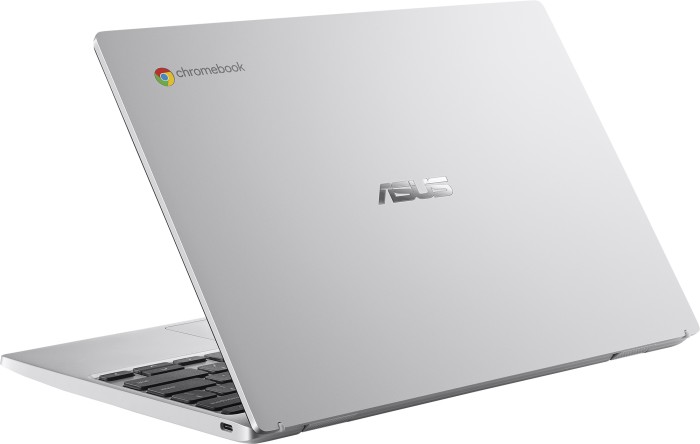Asus Chromebook CX1 Serie
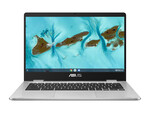 Prozessor: Intel Celeron Celeron N3350, Intel Gemini Lake Celeron N4020, Intel Jasper Lake Celeron N4500
Prozessor: Intel Celeron Celeron N3350, Intel Gemini Lake Celeron N4020, Intel Jasper Lake Celeron N4500Grafikkarte: Intel HD Graphics 500, Intel UHD Graphics (Jasper Lake 16 EU), Intel UHD Graphics 600
Bildschirm: 11.60 Zoll, 14.00 Zoll, 15.60 Zoll
Gewicht: 1.2kg, 1.23kg, 1.24kg, 1.8kg
Preis: 250, 380 Euro
Durchschnitt von 5 Bewertungen (aus 7 Tests)
Asus Chromebook CX1100CNA-GJ0035
Ausstattung / Datenblatt
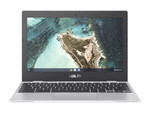 Notebook: Asus Chromebook CX1100CNA-GJ0035
Notebook: Asus Chromebook CX1100CNA-GJ0035Prozessor: Intel Celeron Celeron N3350
Grafikkarte: Intel HD Graphics 500
Bildschirm: 11.60 Zoll, 16:9, 1366 x 768 Pixel
Gewicht: 1.2kg
Preis: 250 Euro
Links: Asus Startseite Asus Notebooks Übersichtseite
Preisvergleich
Bewertung:
Ausländische Testberichte
Quelle: Gadgets Now
 EN→DE Archive.org version
EN→DE Archive.org versionAsus Chromebook CX1101 comes with a price tag of Rs 19,990. The device can be an ideal choice for those who are looking for an affordable laptop and also want to use another operating system. Its ruggedised design, long battery backup and smooth performance act as an added advantage. The device can also be a pick for students who are busy taking online classes due to the pandemic.
Einzeltest, online verfügbar, Kurz, Datum: 27.12.2021
Bewertung: Gesamt: 70%
Quelle: Trusted Reviews
 EN→DE Archive.org version
EN→DE Archive.org versionThe Asus Chromebook CX1 is an okay Chromebook designed for casual users. It offers up a 15.6-inch display with passable brightness, alongside a relatively tactile keyboard and a pretty average port selection. If you’re on a budget and after a large-screen Chromebook, then this is a decent option. Otherwise, its generic design and small trackpad aren’t going to be turning many heads anytime soon.
Einzeltest, online verfügbar, Lang, Datum: 09.11.2021
Bewertung: Gesamt: 70%
Quelle: It Pro
 EN→DE Archive.org version
EN→DE Archive.org versionThe CX1’s threadbare feature set, sluggish performance and disappointing display are no surprise when you consider the £191 exc VAT price. And, for that money, Asus has delivered a machine that’ll run basic computing tasks inside a tiny, portable chassis. The price is the CX1’s best attribute, though, and it’s undermined by its poor performance in most other key departments. It’s worth consideration if you need a bargain, but saving up some more cash will ensure you get a far better Chrome OS experience.
Einzeltest, online verfügbar, Kurz, Datum: 15.10.2021
Bewertung: Gesamt: 60%
Asus Chromebook CX1101
Ausstattung / Datenblatt
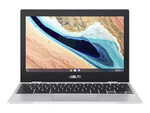 Notebook: Asus Chromebook CX1101
Notebook: Asus Chromebook CX1101Prozessor: Intel Gemini Lake Celeron N4020
Grafikkarte: Intel UHD Graphics 600
Bildschirm: 11.60 Zoll, 16:9, 1366 x 768 Pixel
Gewicht: 1.24kg
Links: Asus Startseite Asus Notebooks Übersichtseite
Preisvergleich
Bewertung:
Ausländische Testberichte
Quelle: The Indian Express
 EN→DE Archive.org version
EN→DE Archive.org versionChromebooks have found a niche during the pandemic, something Google and its partners always wanted – especially in a market like India. The Chromebook CX1101 comes with a strong build and battery life that lasts all day. The screen is okay, rather than outstanding and the design of the device is great. Chromebooks I feel are getting much better. They are reasonably priced, and the fact that they cater to users who want to use primarily web apps and simplistic computing tasks, Chromebooks work like a charm.
Einzeltest, online verfügbar, Mittel, Datum: 13.12.2021
Bewertung: Gesamt: 80%
Asus Chromebook CX1 CX1500CNA-EJ0040
Ausstattung / Datenblatt
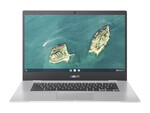 Notebook: Asus Chromebook CX1 CX1500CNA-EJ0040
Notebook: Asus Chromebook CX1 CX1500CNA-EJ0040Prozessor: Intel Celeron Celeron N3350
Grafikkarte: Intel HD Graphics 500
Bildschirm: 15.60 Zoll, 16:9, 1920 x 1080 Pixel
Gewicht: 1.8kg
Preis: 380 Euro
Links: Asus Startseite Asus Notebooks Übersichtseite
Preisvergleich
Bewertung:
Ausländische Testberichte
Quelle: Techradar
 EN→DE
EN→DEThere is something to be said for a cheap Chromebook capable of getting some work or basic computing tasks done on the go, but the Asus Chromebook CX1500 struggles to clear even that low bar. The CX1500 has some appealing features. There's the 15.6-inch, full HD (1080p) IPS display, which is not something you typically see in a Chromebook at this price. Originally, its retail price in the US was $269 (about £200/AU$375) but that has fallen to just under $230 online when we checked recently. We've asked Asus for some clarity on the the exact pricing and availability in the UK and Australia, and will update this review when we hear back from the company.
Einzeltest, online verfügbar, Mittel, Datum: 19.01.2022
Bewertung: Gesamt: 60%
Asus Chromebook CX1400
Ausstattung / Datenblatt
 Notebook: Asus Chromebook CX1400
Notebook: Asus Chromebook CX1400Prozessor: Intel Jasper Lake Celeron N4500
Grafikkarte: Intel UHD Graphics (Jasper Lake 16 EU)
Bildschirm: 14.00 Zoll, 16:9, 1920 x 1080 Pixel
Gewicht: 1.23kg
Links: Asus Startseite Asus Notebooks Übersichtseite
Preisvergleich
Ausländische Testberichte
Quelle: India Today
 EN→DE
EN→DEThe Asus Chromebook CX1400 isn't just for media consumption, it's handy for students and casual users. Priced at Rs 19,999 on Amazon, it offers more features for its cost. Yet, it has a few drawbacks. Its design is simple and sturdy, but the keyboard feels a bit shaky. The touchpad isn't as responsive as other laptops in its price range, so using a separate mouse might be better. It comes with useful ports and can turn into a tablet, which is pretty neat. The screen is good, and the speakers make sound better. However, when I opened many tabs, it slowed down, especially with online tools. It doesn't get too hot, but the webcam isn't great, and some apps might not work perfectly. The battery lasted around 9 hours, not the promised 11 hours, which is still pretty good.
Einzeltest, online verfügbar, Kurz, Datum: 07.12.2023
Quelle: Techlusive
 EN→DE
EN→DEAs promised, here’s the answer to “Who should buy the Asus Chromebook”. If you’re a student, or a writer, or your work revolves around Chrome or Android apps, you can buy this machine. Asus’ pricing makes it a sweet deal for students, and the battery backup ensures you can use it for hours without worrying about it dying on you. For writers and other office users, anything you can do in Chrome or on your phone, you can do on this machine. Even some light photo and video editing tasks run smoothly as you can install apps for them. Moreover, the 360-degree hinge, touchscreen, and affordable pricing also mean you can have it as a personal or secondary machine. Now, heavy users like gamers, coders, and video editors are better off with a Windows or Apple machine. But at this price, there are no alternatives to the value that the Asus Chromebook CX1400 has to offer. You can buy a more expensive machine and get more value out of it, but in my testing, this Chromebook seems good enough for most users who primarily work on Chrome.
Einzeltest, online verfügbar, Kurz, Datum: 07.11.2023
Kommentar
Asus: ASUSTeK Computer Inc. ist ein großer taiwanesischer Hersteller von Computer-Hardware mit Sitz in Taipeh, gegründet 1989. Unter dem Markennamen Asus fertigt das Unternehmen eine breite Palette von Produkten, darunter Laptops, Desktops, Motherboards, Grafikkarten, Monitore, Smartphones und Netzwerkgeräte, Komplettsysteme und PC-Bauteile für Endkunden.
Unter dem Markennamen ROG (Republic of Gamers) stellt ASUS Gaming-Laptops her, die bei Spielern für ihre leistungsstarken Spezifikationen, dedizierten Grafikkarten, Displays mit hoher Bildwiederholrate und fortschrittlichen Kühlsystemen bekannt sind.
Über das Gaming hinaus werden eine breite Palette von Notebooks für unterschiedliche Anforderungen und Budgets geboten: von ultraschlanken und leichten Ultrabooks bis hin zu vielseitigen 2-in-1-Convertibles und budgetfreundlichen Optionen. 2023 hatte Asus einen Weltmarktanteil von 7% am PC-Markts.
Die Kundenzufriedenheit mit ASUS-Notebooks betrifft Leistung, die Funktionen und das gute Preis-Leistungs-Verhältnis der ASUS-Notebooks. Wie bei jeder Marke gibt es jedoch gelegentlich Berichte über Probleme wie Überhitzung, Treiberkompatibilität oder Probleme mit der Verarbeitungsqualität.
Einige nicht anspruchsvolle aktuelle Spiele können mit geringen Details noch flüssig gespielt werden. Für Office und Video natürlich ausreichende Leistungsreserven.
Intel HD Graphics 500: Integrierte Low-End-Grafikkarte mit DirectX-12-Unterstützung, welche in einigen ULV-SoCs der Apollo-Lake-Serie zu finden ist.
Intel UHD Graphics 600: Integrierte Low-End-Grafikkarte mit DirectX-12-Unterstützung, welche in einigen ULV-SoCs der Gemini-Lake-Serie zu finden ist.
Intel UHD Graphics (Jasper Lake 16 EU): Integrierte Grafikkarte (in Jasper Lake Pentium Silver SoCs) der Gen. 11 Architektur mit 16 der 32 EUs (Shader-Cluster). Taktet mit 350 MHz Basistakt und bis zu 800 MHz Boost. Der Chip wird im 10nm Verfahren bei Intel gefertigt.
» Weitere Informationen gibt es in unserem Notebook-Grafikkartenvergleich und der Benchmarkliste.
Intel Celeron:
Celeron N3350: Sparsamer Dual-Core-SoC aus der Apollo-Lake-Serie für preiswerte Notebooks. Taktet mit 1,1 bis 2,4 GHz und integriert eine DirectX-12-fähige Grafikeinheit. Im Vergleich zu früheren Atom-Generation wurde die Pro-MHz-Leistung der CPU-Architektur signifikant gesteigert und ebenso die Grafikeinheit verbessert.
Intel Gemini Lake:
Celeron N4020: Sparsamer Dual-Core-SoC aus der Gemini-Lake-Serie für preiswerte Notebooks. Taktet mit 1,1 bis 2,8 GHz und integriert eine DirectX-12-fähige Grafikeinheit. Im Vergleich zu der Core-Y-Serie mit langsameren CPU Kernen ausgestattet.
Intel Jasper Lake:
Celeron N4500: Sparsamer Dual-Core-SoC aus der Jasper-Lake-Serie für preiswerte Notebooks. Taktet mit 1,1 bis 2,8 GHz und integriert eine DirectX-12-fähige Grafikeinheit mit 16 Kernen und max. 750 MHz Taktrate. Im Vergleich zu der Core-Serie (Ice Lake) mit langsameren CPU Kernen ausgestattet aber im selben 10nm Prozess bei Intel gefertigt.
» Weitere Infos gibt es in unserem Prozessorvergleich Vergleich mobiler Prozessoren und der Prozessoren Benchmarkliste .
14.00:
14 Zoll Display-Grösse stellt ein Mittelding zwischen den kleinen Subnotebook-Formaten und den Bildschirmen der 15 Zoll-Standard-Laptops dar.
Der Grund der Beliebtheit mittelgrosser Displays ist, dass diese Größe einigermaßen augenschonend ist, gute Auflösungen mit brauchbaren Detailgrößen liefern und dennoch nicht allzu viel Strom verbraucht und die Geräte noch halbwegs kompakt sein können.
Früher waren 14 Zoll-Geräte sehr selten, jetzt stellen sie nach den 15-Zollern den Standard bei Laptops dar.
» Prüfen Sie in unserer DPI Liste, welche Displays wie fein aufgelöst sind.
1.2 kg:
Most smartphones and only a few tablets fall into this weight category. Only a few smartphones are heavier and should rather be considered tablets.
1.8 kg:
In this weight range, there are particularly light laptops, convertibles and subnotebooks that are trimmed for good portability.
68%: Diese Bewertung ist schlecht. Locker drei Viertel der Modelle werden besser beurteilt. Das ist eher keine Kaufempfehlung. Auch wenn Verbalbewertungen in diesem Bereich gar nicht so schlecht klingen ("genügend" oder "befriedigend"), meist sind es Euphemismen, die eine Klassifikation als unterdurchschnittliches Notebook verschleiern.
» Lesen Sie auch unsere Notebook-Kaufberatung.


